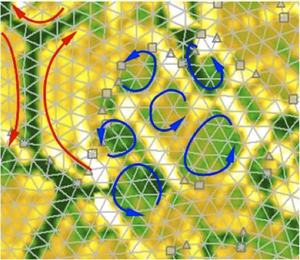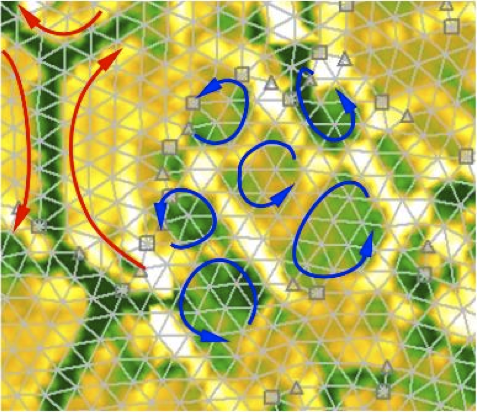Tracking Rearrangements in a 2D Liquid
A liquid near its freezing temperature is hardly random; it contains small domains of crystal-like order. To understand how these domains jostle and slide past each other, researchers reporting in Physical Review Letters tracked beads floating in a plasma and confined to two dimensions, a system that behaves like a 2D liquid. The team catalogued several types of rearrangements that occurred among the crystal-like domains that formed. While the direct connection between 2D and 3D liquid behavior remains unclear, the team says their results provide a step toward a better understanding of liquid phenomena in general.
Experiments that probe the atomic arrangements inside a crystalline solid have been available for decades. But for disordered materials like liquids, these probes reveal mostly statistical averages, rather than the quirky local arrangements around individual atoms. Computer simulations can reveal these microscopic details, but they become unwieldy for realistic systems containing thousands of atoms.
To overcome these limitations, experimenters have sometimes turned to analog model systems, in which the role of atoms is played by much larger particles that can be directly viewed. It’s easiest to see what’s happening in 2D model systems, which may differ in important ways from real, 3D liquids but can also show interesting new phenomena. For example, experiments that used suspensions of micron-sized plastic beads in a liquid sandwiched between glass plates showed that the beads can organize into unique two-dimensional phases, as predicted by theorists. In the past decade, many researchers have also begun embedding similar beads into plasma, where their movement is more like that of a free particle, because the viscosity is much lower.
Lin I and his team at the National Central University in Jhongli, Taiwan, use 7-micron-diameter beads in a plasma generated in dilute argon gas by a radio-frequency electric field. The beads become charged and repel one another but still form into hundreds of vertical chains, suspended a few millimeters over the horizontal metal plate that serves as the electrode. These chains move as units horizontally, like solid vertical rods, and form a 2D liquid of repelling particles.
I and his team tracked the motions of individual rods over many seconds using a digital camera. Compared with previous work, they followed the rearrangements over a longer time and analyzed the motion in detail. The team calculated the distances and angles between neighboring rods, as well as the number of neighbors for each rod. This analysis allowed them to catalog the different types of rearrangements that give rise to the constantly changing structure of the liquid. In many regions, the rods form into local patches arranged in a triangular lattice, where each rod can only jiggle within the hexagonal “cage” created by its neighbors. Individual patches can also drift or rotate as rigid objects. “It’s like a patchwork,” I says, but “each patch is not so robust. It can be broken up by thermal excitation.”
The researchers identified two types of boundary between moving patches. In one type, all of the rods move more or less simultaneously in one direction, like dancers in a conga line. In the other type, rods on opposite sides of the line move in opposite directions. This “two-lane highway” happens, for example, at the boundary between neighboring small patches that are both rotating clockwise. The team found that when a large patch is nudged by external forces to rotate, it breaks up into these smaller rotating patches, which eventually stop rotating and reconnect, to recreate the large patch again. The researchers suggest that breaking up this way, rather than rotating as a single large block, allows the liquid to respond more easily to external rotational forces.
“I’m really kind of intrigued by the detail with which these authors are able to photograph and to follow in time the evolution of these various cooperative processes,” says Frank Stillinger of Princeton University, who had long ago proposed similar descriptions motivated by computer simulations. “But this is real stuff,” he says. “That is an important distinction.” Still, it remains unclear which aspects of the structural rearrangements in this 2D system are replicated in familiar, 3D liquids. It’s “easy to argue both sides of that question,” Stillinger says, but “2D systems in their own right are something that one would like to understand.”
–Don Monroe
Don Monroe is a freelance science writer in Murray Hill, New Jersey.





